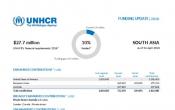India
Operation: India
Location
{"longitude":83,"latitude":22,"zoom_level":5,"iso_codes":"'IND'"}
By clicking on the icons on the map, additional information is displayed.
Key Figures
| 2017 year-end results | |
| 95% | of unaccompanied and separated children have had a Best Interest Determination or Assessment initiated or completed |
| 30,300 | people were registered using biometrics |
| 3,300 | people with specific needs received cash grants |
| 1,500 | Sri Lankan refugees were facilitated a safe return |
| 230 | campaigns to promote peaceful co-existence with the local community were conducted |
| 2018 planning figures | |
| 10,000 | refugees and asylum-seekers will be trained on SGBV prevention and response |
| 4,790 | refugees and asylum-seekers will receive self-reliance and livelihoods support |
| 4,200 | people with specific needs will receive cash grants |
| 1,600 | refugees and asylum-seekers will be enrolled in accelerated learning programmes |
People of Concern
0%
Decrease in
2016
2016
| 2016 | 207,070 |
| 2015 | 207,861 |
| 2014 | 205,012 |

[["Refugees",197851],["Asylum-seekers",9219]]
Loading ...
India
< Back
2017
{"categories":[2013,2014,2015,2016,2017,2018],"budget":[13.00711233,13.6245752,14.714199194,15.0618463,15.23043623,15.81443432],"expenditure":[6.37884488,6.5466772,6.1390603,5.49998666,6.68339873,null]}
{"categories":[2013,2014,2015,2016,2017,2018],"p1":[12.92828938,13.5945752,14.612301274,14.98733329,15.12416628,15.63343432],"p2":[0.07882295,0.03,0.10189792,0.07451301,0.10626995,0.181],"p3":[null,null,null,null,null,null],"p4":[null,null,null,null,null,null]}
{"categories":[2013,2014,2015,2016,2017,2018],"p1":[6.30452047,6.52077953,6.05843666,5.43533496,6.57782877,null],"p2":[0.07432441,0.02589767,0.08062364,0.0646517,0.10556996,null],"p3":[null,null,null,null,null,null],"p4":[null,null,null,null,null,null]}
Loading ...
CHOOSE A YEAR
- 2015
- 2016
- 2017
- 2018
Operational context
The traditionally generous protection environment in India became constrained in 2017, impacting refugees’ access to documentation and basic services, as well as the right to seek asylum. Increased incidents of harassment and evictions, particularly of Rohingya refugees, were reported. UNHCR initiated contingency plans to assist people of concern to relocate from areas of tension or risk, and to intervene immediately in the event of possible deportation or refoulement.Population trends
At the end of 2017, UNHCR recorded close to 38,000 refugees and asylum-seekers, a 12 per cent increase from 2016. Refugees from Myanmar constitute over half of the population, followed by Afghan asylum-seekers, who continued to arrive in increasing numbers. At the end of 2017, more than half of the refugees and asylum-seekers were located outside Delhi, as compared to just 12 per cent five years before.
Key achievements
Early identification and assessment of at-risk and vulnerable individuals was carried out for 2,600 cases, of whom some 1,190 were assisted with subsistence allowance (SA). Cash-based interventions (CBIs) for the vulnerable Rohingya formed an integral part of the displacement contingency plan, under which some 540 Rohingya families (2,100 individuals) were assessed for vulnerability and were assisted with financial support largely in Jammu, Mewat, Hyderabad, Delhi, Faridabad, Mathura and Jaipur. Post distribution monitoring carried out across five locations found that the CBIs provided an effective safety net.Unmet needs
Gaps in access to government healthcare, education, civil documentation for refugees based outside Delhi persisted. UNHCR and partners were able to improve access, however an enhanced partner presence is required to further scale up access and linkages. As a result, reliable access to public health care, birth certificates, education, and prevention of sexual and gender-based violence directly or through operational partnerships remained limited outside Delhi for many refugees.Due to inadequate financial resources, partners could only engage limited number of specialized staff in key areas of child protection, SGBV, education, health and community development. Thus, child labor/marriage and teenage pregnancy, access to information/services continues to be reported as major problem.
The general insufficiency of water, lack of toilets and poor sanitation in settlements remained a major problem impacting negatively on the health of people of concern. In particular, the reproductive health and dignity of women and girls was impacted negatively.
Working environment
The protection environment in India remains generally positive. Refugees and asylum-seekers continue to enjoy access to Government services, including health and education. The Government has simplified the long term visa (LTV) application procedures, with a waiver of overstay fines and easing of documentary requirements, helping refugees to be more self-reliant. Overstay fines were also exempted for Afghan refugees departing India.The detention of people of concern to UNHCR—mostly of Rohingya asylum-seekers in border areas—continues to be reported. UNHCR is conducting awareness-raising activities on refugee protection, including with border officials. Direct access to people in detention remains a challenge, despite some outreach being provided through partners.
Key priorities
In 2017 UNHCR will intensify its efforts in facilitating enhanced inclusion of refugees and asylum seekers into existing national services, supporting livelihoods, and strengthening the capacity of civil society to support refugees. UNHCR continues to reorient protection and assistance in Delhi, allowing more focus and resources for refugees residing outside Delhi through outreach activities and networking. UNHCR will continue to shift towards community-based approach.UNHCR will also continue to expand the scope of outstation registration and refugee status determination missions in locations where refugees are concentrated outside of Delhi. UNHCR’s efforts will be intensified to assist refugees in applying for LTVs which enhance their access to Government services. Community mobilization remains a priority for all nationalities.
If the Governments of India and Sri Lanka agree on a large-scale return programme, UNHCR anticipates that 4,000 Sri Lankan refugees may return to Sri Lanka. UNHCR will support the safety and dignity of the returnees.
